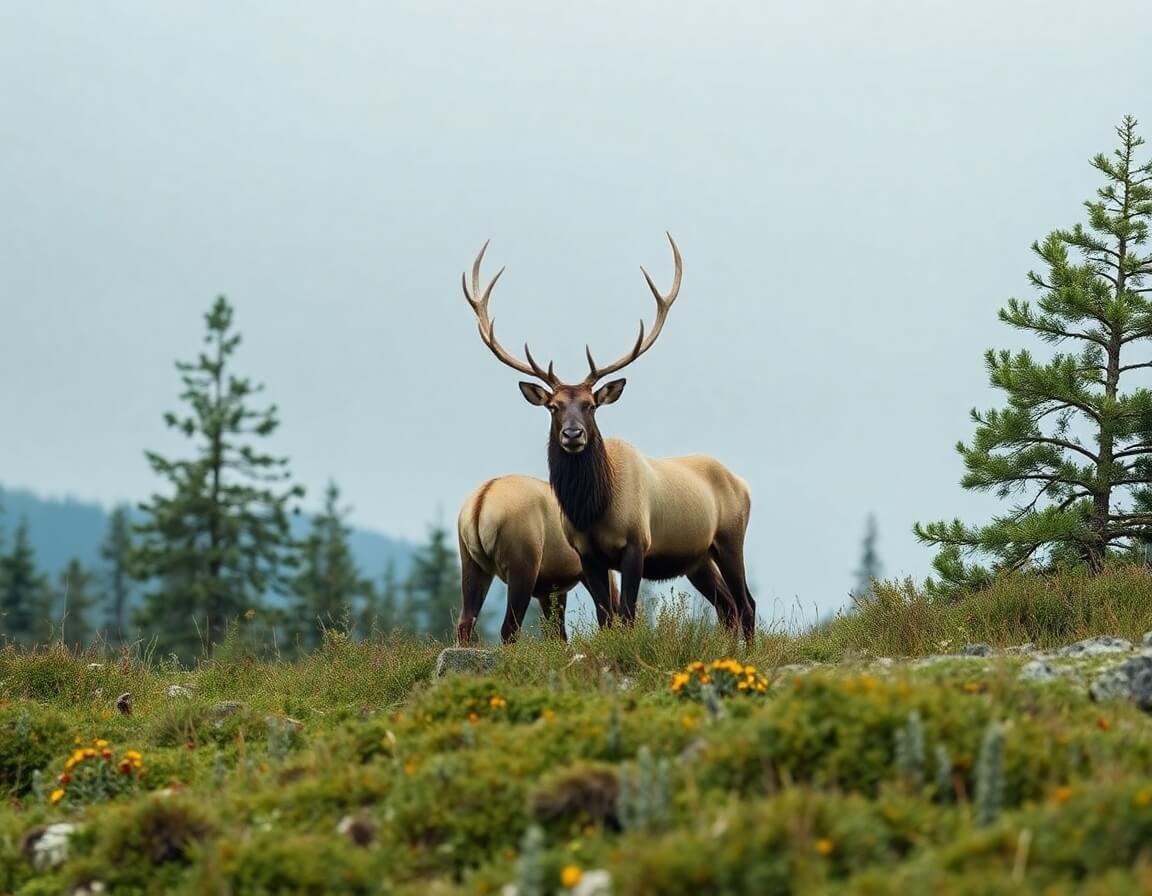Elk Bledom, a name that might seem unfamiliar to many, is a fascinating and somewhat mysterious term that has garnered the interest of wildlife enthusiasts, researchers, and explorers. While “elk” refers to the majestic and influential North American deer species, “Bledom” is lesser-known and often confused. This article will dive deep into what “elk bloom” represents, where it is found, why it is so intriguing, and how it plays a role in the ecosystems it inhabits.
Whether you’re a seasoned wildlife expert or a curious adventurer, this article will provide a comprehensive understanding of elk blooms, from their biological characteristics to their environmental significance.
What is Elk Bledom?
At the outset, it’s important to clarify that “elk bloom” is not commonly used in wildlife biology. Instead, it is a combination of two words: elk and bledom. Let’s start by understanding these terms individually before we delve into their unique combination.
The Elk: A Majestic Creature
The elk (Cervus canadensis), also known as wapiti, is one of the largest species in the deer family. Native to North America, the elk is known for its striking antlers, which grow in large, impressive racks. These creatures are commonly found in forests, grasslands, and mountainous areas. With their majestic appearance and distinctive bugling calls during mating season, elk symbolise wilderness in many parts of the world.
Elk typically live in herds, with males (bulls) and females (cows) living separately outside the breeding season. Bulls are known for their elaborate courtship displays, which include loud bugling and physical posturing to assert dominance. Elk are herbivores, feeding primarily on grasses, shrubs, and trees. They play a critical role in ecosystems by controlling plant growth and providing food for predators such as wolves and bears.
The Mystery of Bledom
On the other hand, Bledom is not a common term within the context of wildlife or biology. Upon research, “bloom” could potentially refer to a name, location, or a term used in regional contexts. However, for this article, we will explore an interpretation that aligns with current understanding—considering “bloom” as a conceptual link between the elk and its environment or perhaps a reference to an ecosystem or a location where elk thrive.
In this context, “elk bloom” is a unique ecological area or habitat where elk populations are particularly abundant or notable. Elk inhabit areas known for their biodiversity in many parts of the world, such as the Rocky Mountains, the Pacific Northwest, and parts of Europe and Asia. The word “bloom” could symbolically represent an ideal habitat for elk, where they interact with diverse flora and fauna.
Elk Bledom: The Ideal Habitat
For elk to thrive, they need a balance of vegetation, water sources, and safe havens from predators. Areas where elk are most commonly found often feature a variety of terrains—from dense forests and open meadows to mountainous regions and river valleys.
Rocky Mountain Region
One of the most famous “elk blooms” is the Rocky Mountain region of North America. This area stretches from Canada to New Mexico and is renowned for its high elevations, rugged terrain, and expansive wilderness. Here, elk roam freely, benefiting from the rich vegetation and the protection provided by the steep hills and forests. The Rocky Mountains are an excellent habitat for elk, with large populations in states like Colorado, Montana, Wyoming, and Idaho. This region also boasts several national parks, such as Yellowstone and Rocky Mountain National Park, where elk can be observed in their natural habitat.
Pacific Northwest
Another prime “elk bloom” can be found in the Pacific Northwest, including parts of Washington, Oregon, and British Columbia. Temperate rainforests, rivers, and coastal plains characterize the region. Elk in this area benefit from a rich variety of plant life, including grasses, shrubs, and trees. Additionally, the abundant rainfall and mild climate make this region an ideal place for elk to thrive, especially during the winter when the weather is more moderate than in mountainous areas.
The European Habitat
Elk are also found in parts of Europe and Asia, where they are referred to as moose (Alces alces). Elk can be found in the northern boreal forests in countries like Sweden, Norway, and Finland. These habitats are rich in coniferous trees, and elk feed primarily on twigs, shrubs, and aquatic plants during the warmer months. Elk have adapted to endure harsh winters in these colder climates and are often seen migrating to lower elevations to avoid deep snow. Like in North America, these elk play an essential ecological role in their habitat, influencing plant growth and providing prey for large predators like wolves and bears.
The Ecological Importance of Elk Bledom
The concept of “elk bloom” can also be explored from an ecological perspective. Elk, as a keystone species, significantly impacts the ecosystems they inhabit. Their presence influences plant communities, soil health, and even the populations of other wildlife species.
Plant Dynamics
Elk are herbivores and feed on various plants, including grasses, shrubs, and tree saplings. As a result, their grazing behaviour helps to shape the landscape by controlling the growth of certain plant species. In areas where elk populations are dense, they can significantly reduce the number of young trees, particularly conifers. This can lead to the growth of more open spaces in forests, which benefits species that rely on open habitats. In some regions, elk have been observed to help maintain the balance of plant species by preventing any single species from becoming too dominant.
Impact on Soil Health
By grazing and moving through their habitat, elk also contribute to soil health. Their hooves break up the ground, which can help with soil aeration. This, in turn, improves nutrient cycling and encourages the growth of a variety of plant species. Elk are also known to create “wallows”—muddy depressions in the ground where they roll to help shed parasites. These wallows can create temporary pools of water, which in turn become important habitats for amphibians, insects, and other wildlife.
Predator-Prey Relationships
Elk also plays an essential role in the food chain. As a primary prey species, they are a vital food source for apex predators like wolves, bears, and cougars. In areas like Yellowstone National Park, the reintroduction of wolves has significantly affected elk populations, creating a more balanced ecosystem. Wolves prey on elk, keeping their numbers in check, which prevents overgrazing of vegetation. This, in turn, benefits other plant and animal species that rely on the same resources.
The Conservation of Elk Bledom
While elk populations are relatively stable in many parts of North America and Europe, conservation efforts are essential to ensure these majestic creatures thrive in their natural habitats. Habitat loss, hunting, and climate change threaten elk populations and their habitats.
Habitat Preservation
Efforts to preserve the elk’s natural habitat are critical to ensuring their long-term survival. National parks, wildlife reserves, and protected areas all play an essential role in maintaining the biodiversity that elk depend on. Many organizations, including the Rocky Mountain Elk Foundation and the National Wildlife Federation, work tirelessly to conserve elk habitats, restore damaged ecosystems, and reduce human-wildlife conflicts.
Hunting Regulations
Hunting is another significant factor in elk population management. While elk hunting is a popular activity, strict regulations ensure that the populations remain healthy and sustainable. The regulations often include limits on the number of elk harvested each year and restrictions on hunting seasons to avoid overhunting during critical times, such as mating season.
Climate Change
Climate change presents a growing challenge for elk populations. As temperatures rise and weather patterns shift, the habitats that elk rely on may begin to change. For example, warmer temperatures may result in earlier snowmelt, which could affect the availability of water and food sources during critical times of the year. Conservationists closely monitor these changes and work to mitigate their impact on elk and other wildlife.
Conclusion
Elk Bledom, while not commonly recognized, can be understood as representing the diverse and rich habitats that elk call home. Whether in the rugged Rocky Mountains, the temperate rainforests of the Pacific Northwest, or the boreal forests of Europe and Asia, elk play an essential role in maintaining the ecological balance of their environments.
Their grazing behaviour shapes plant communities; their presence supports predator-prey dynamics, and their interactions with the land influence soil health. For these reasons, elk are considered a keystone species integral to the health of the ecosystems in which they reside.
As we face environmental challenges such as habitat loss, climate change, and overhunting, preserving elk habitats becomes more critical than ever. Efforts to protect and conserve elk blooms will not only ensure the survival of this iconic species. Still, they will also help maintain the biodiversity and ecological integrity of the lands they inhabit.
So, whether you’re an elk enthusiast, a conservationist, or just someone fascinated by wildlife, the concept of “elk bloom” represents a profound and vital connection between elk and their natural world. This relationship continues to evolve and inspire us all.
you may also read:Why Does My Phone Say SOS Only? Understanding the Common Issue

